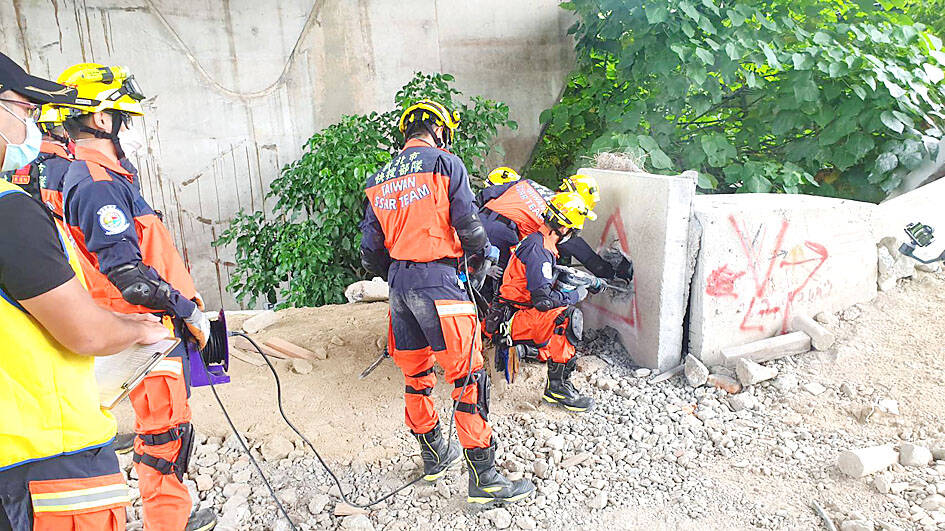A magnitude 5.9 earthquake struck off Taiwan’s east coast at 3:24am yesterday, the Central Weather Bureau said, adding that the nation has seen more active and frequent seismic activity this year.
The hypocenter of yesterday’s earthquake was 59.3km east of Hualien County Hall at a depth of 17.9km, data collected by the bureau’s Seismological Center showed.
The earthquake was felt nationwide, with the largest intensity reaching level 4, the bureau said.

Photo courtesy of the New Taipei City Fire Department
No casualties were reported as of press time last night.
Residents on the east coast are still recovering from severe infrastructure damage caused by a magnitude 6.8 earthquake on Sept. 18.
Yesterday’s earthquake was caused by the Philippine Sea Plate subsiding into the Eurasian Continental Plate, Seismological Center Director Chen Kuo-chang (陳國昌) said, adding that it was not related to the Sept. 18 quake.
However, the epicenter of yesterday’s earthquake was almost in the same region as that of a magnitude 6.06 earthquake on Jan. 3, Chen said.
Since 1973, only 25 earthquakes exceeding magnitude 5.5 at a depth of less than 30km have been detected in that region, eight of which exceeded magnitude 6, Chen said.
The biggest one that occurred in the region was a magnitude 6.8 earthquake on March 31, 2002, he said.
Construction on the Taipei 101 building was suspended as a crane on the building’s roof fell after the quake, killing five workers and damaging multiple vehicles, Chen said.
While certain locations, such as Taipei’s Xinyi District (信義), are far from the epicenter, residents tend to experience intense shaking due to seismic site effects, in which seismic waves are amplified in superficial geological layers, he said.
Although yesterday’s earthquake nearly reached magnitude 6, it is not likely to trigger many aftershocks, Chen said.
“The earthquake occurred in a geologically fragmented zone, so aftershocks should occur quickly afterward. Our estimate is that no aftershock will occur if nothing happened the day after the earthquake. If there is an aftershock, it could reach magnitude 4.5 or greater,” he said.
Chen said that aftershocks triggered by the earthquake on Sept. 18 have shown signs of gradually subsiding, although the bureau still recorded four aftershocks on Monday, which was “unusual.”
Seismic activity around Taiwan proper has been more active and frequent this year, Chen said.
Taiwan has an average of two or three earthquakes exceeding magnitude 6 per year, but eight earthquakes larger than magnitude 6 have been recorded so far this year, he said.
“As of yesterday, 55 earthquakes of magnitude 5 to 6 had occurred this year. The average, however, is 24 to 25 per year,” Chang said, adding that more seismic activity is expected during the remainder of this year.

A strong continental cold air mass is to bring pollutants to Taiwan from tomorrow, the Ministry of Environment said today, as it issued an “orange” air quality alert for most of the country. All of Taiwan except for Hualien and Taitung counties is to be under an “orange” air quality alert tomorrow, indicating air quality that is unhealthy for sensitive groups. In China, areas from Shandong to Shanghai have been enveloped in haze since Saturday, the ministry said in a news release. Yesterday, hourly concentrations of PM2.5 in these areas ranged from 65 to 160 micrograms per cubic meter (mg/m³), and pollutants were

Taiwan’s armed forces have established response protocols for a wide range of sudden contingencies, including the “Wan Chun Plan” to protect the head of state, the Ministry of Defense (MND) said today. After US President Donald Trump on Saturday launched a series of airstrikes in Venezuela and kidnapped Venezuelan President Nicolas Maduro, concerns have been raised as to whether China would launch a similar “decapitation strike” on Taiwan. The armed forces regularly coordinate with relevant agencies and practice drills to ensure preparedness for a wide range of scenarios, Vice Minister of National Defense Hsu Szu-chien (徐斯儉) told reporters before a

EVA Airways on Saturday said that it had suspended a pilot and opened an investigation after he allegedly lost his temper and punched the first officer several times as their plane was taxiing before takeoff at Los Angeles International Airport. According to a report published on Thursday by The Reporter, the incident occurred after the flight’s Malaysian first officer tried to warn the Taiwanese pilot, surnamed Wen (文), that he was taxiing faster than the speed limit of 30 knots (55.6kph). After alerting the pilot several times without response, the first officer manually applied the brakes in accordance with standard operating

Japanese Councilor Hei Seki (石平) on Wednesday said that he plans to visit Taiwan, saying that would “prove that Taiwan is an independent country and does not belong to China.” Seki, a member of the Japan Innovation Party, was born in Chengdu in China’s Sichuan Province and became a naturalized Japanese in 2007. He was elected to the House of Concilors last year. His views on the Chinese Communist Party (CCP) — espoused in a series of books on politics and history — prompted Beijing to sanction him, including barring Seki from traveling to China. Seki wrote on X that he intends